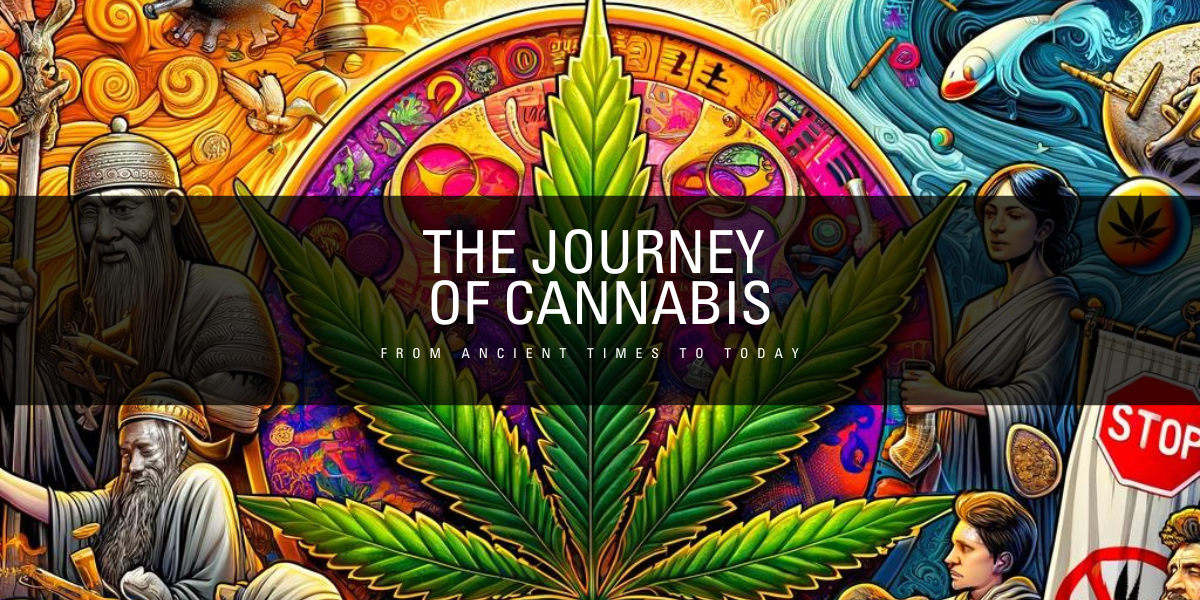Cannabis is by no means a new plant, but rather one that has grown alongside humans for thousands of years. From its early medicinal and spiritual uses to the changing perceptions over time leading to prohibition, cannabis has a long and storied history now coming full circle with legalization sweeps the globe.
Ancient Uses of Cannabis
Cannabis is believed to have originated in Central Asia, with some of the earliest evidence of its use by humans found in ancient Chinese tombs dating back to 4000 BC. Throughout various ancient societies in China, India, Greece, and elsewhere, cannabis was viewed as a medicinal and sacred plant used for a variety of purposes.
The Pen Ts’ao Ching, a Chinese text from 2700 BC, recorded some of the earliest known uses of cannabis for conditions such as rheumatism, intestinal constipation, disorders of the female reproductive system, malaria, and absent-mindedness. Roman historian Herodotus wrote around 400 BC about how Scythians would inhale cannabis smoke in vapor baths and tents, likely for ritualistic or psychoactive purposes. Ancient Indians similarly used cannabis to relieve stress and other ailments, honor the god Shiva, and more.
In addition to medicinal and spiritual applications, cannabis’ tough fibers were used to create cloth, paper, rope, and other materials in China, India, the Arab world, and colonial America, where it was a common crop needing little care to grow. While recreational cannabis use likely occurred in various societies, it became more prominently documented starting in the 19th century in parts of Asia, the Middle East, Latin America, and Africa.
Shifting Perceptions in the 1900s
By the early 1900s, perceptions towards cannabis began to shift, particularly in Western countries. Stigmatization arose from a number of factors – associating cannabis with marginalized groups, exaggerated media stories sowing fear, and pressure from industries who viewed hemp as an economic threat. Racist propaganda propagated myths linking cannabis to crime and people of color despite little evidence. This stigmatization culminated in increasingly restrictive laws against both recreational and medical cannabis through the 20th century.
The Marijuana Tax Act of 1937 in the United States set the stage for cannabis prohibition both nationally and internationally. Strict regulations made medical use nearly impossible, while recreational use was highly criminalized, kicking off America’s infamous “War on Drugs” in the 1970s. Other Western countries followed suit enacting similar anti-cannabis legislation and Crackdowns intensified, lives were derailed by harsh penalties for minor cannabis offenses, and myths continued circulating despite conflicting evidence.
The Modern Cannabis Movement
Recently, a paradigm shift has begun to take place as many countries reexamine previous cannabis laws. Momentum has swung back towards legal regulation through a grassroots-turned-mainstream Modern Cannabis Movement.
In 1996, medical marijuana first became legal in California, ushering in a state-by-state turn towards legal medicinal access in the US. As more scientific research demonstrated cannabis’ therapeutic potential for pain, epilepsy, PTSD, and even potential cancer applications, public perceptions gradually changed in favor of compassionate medical use.
Recreational legalization picked up steam starting with Uruguay and several US states in 2012. Canada federally legalized recreational use in 2018 with other nations exploring new legislation and allowing personal use. As legal access opened up, products diversified, state-licensed dispensaries replaced street dealers, and cannabis became seen as a consumer product rather than illicit substance.
A Budding Future
Modern attitudes continue shifting away from the unfounded stigma and restrictions of the past towards responsible legal access. Medical cannabis helps improve quality of life for many patients while regulated recreational markets generate tax revenue, undermine criminal enterprises, and give adults freedom of choice. There is still progress needed around social justice and equity given past criminalization. Overall though, the future continues looking brighter and brighter green.
Cannabis’ history has come full circle – from ancient plant ally back to modern plant ally. Just as our ancestors discovered and utilized its bountiful benefits, we have the privilege today of safe, legal access. The cannabis plant’s almost spiritual journey invites us to celebrate how far our understanding has come and explore mindfully where it might grow next.
Sources:
- History of Cannabis – Wikipedia
- A Brief History of Medical Cannabis – National Center for Biotechnology Information
- Cannabis and Spirituality: A History – Leafly
- A Timeline of Recreational Cannabis Legalization in the United States – WeedMaps

